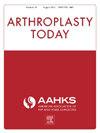使用滑动闭合技术戴手套在手套-手套界面与污染的距离更大
IF 2.1
Q3 ORTHOPEDICS
引用次数: 0
摘要
背景手术服-手套界面是细菌污染的已知原因。通过在无菌助手的帮助下优化戴手套的技术,可以最大限度地减少这个界面的污染。本研究的目的是评估采用新型滑闭(SC)手套技术与传统开放式手套技术时手套袖口内部的污染程度。方法对传统的开放式手套技术和新型的SC手套技术进行了对比研究。外科医生在穿上手术服和无菌手套之前使用紫外线指示剂。3名外科医生对SC技术有经验,3名外科医生对该技术没有经验。每只手套的污染情况由两名盲检人员在一个黑暗的房间里通过测量手套袖口到最近污染点的距离来分析。结果无论以往的经验如何,与开放技术相比,SC技术与污染的距离明显更大(开放= 65 mm[四分位数范围46.3-98.8],SC = 150 mm[四分位数范围110-170],P≤0.001)。有使用SC技术经验的外科医生与污染的中位距离(125 mm)比没有使用该技术经验的外科医生(90 mm, P = 0.002)大。结论与传统的开放式手套技术相比,sc辅助手套技术的袖口与污染的距离明显增大。外科医生应考虑采用这种技术,以帮助降低感染风险,同时采取标准的感染控制措施。本文章由计算机程序翻译,如有差异,请以英文原文为准。
Donning Gloves Using the Sliding-Closed Technique Has a Larger Distance to Contamination at the Gown-Glove Interface
Background
The surgical gown-glove interface is a known cause of bacterial contamination. Minimizing contamination from this interface can be achieved by optimizing the technique for donning gloves with the help of a sterile assistant. The purpose of this study was to evaluate the level of contamination of the inside of the glove cuff when employing a novel sliding-closed (SC) gloving technique vs a traditional open gloving technique.
Methods
We conducted a comparative study between a traditional open gloving technique and a novel SC gloving technique. Surgeons applied ultraviolet indicator lotion before donning a surgical gown and sterile gloves using either technique. Three surgeons were experienced with the SC technique and 3 surgeons had no experience with this technique. Contamination of each glove was analyzed by 2 blinded inspectors in a darkened room by measuring the distance from the cuff to the closest contamination.
Results
Regardless of previous experience, the SC technique had a significantly greater distance to contamination compared to the open technique (open = 65 mm [interquartile range 46.3-98.8], SC = 150 mm [interquartile range 110-170], P ≤ 0.001). Surgeons with experience using the SC technique had a greater median distance to contamination (125 mm) than those who without experience with this technique (90 mm, P = .002).
Conclusions
Performing the SC-assisted gloving technique results in a significantly greater cuff to contamination distance, compared to the traditional open gloving technique. Surgeons should consider adopting this technique to help minimize infection risk alongside standard infection control measures.
求助全文
通过发布文献求助,成功后即可免费获取论文全文。
去求助
来源期刊

Arthroplasty Today
Medicine-Surgery
CiteScore
2.90
自引率
0.00%
发文量
258
审稿时长
40 weeks
期刊介绍:
Arthroplasty Today is a companion journal to the Journal of Arthroplasty. The journal Arthroplasty Today brings together the clinical and scientific foundations for joint replacement of the hip and knee in an open-access, online format. Arthroplasty Today solicits manuscripts of the highest quality from all areas of scientific endeavor that relate to joint replacement or the treatment of its complications, including those dealing with patient outcomes, economic and policy issues, prosthetic design, biomechanics, biomaterials, and biologic response to arthroplasty. The journal focuses on case reports. It is the purpose of Arthroplasty Today to present material to practicing orthopaedic surgeons that will keep them abreast of developments in the field, prove useful in the care of patients, and aid in understanding the scientific foundation of this subspecialty area of joint replacement. The international members of the Editorial Board provide a worldwide perspective for the journal''s area of interest. Their participation ensures that each issue of Arthroplasty Today provides the reader with timely, peer-reviewed articles of the highest quality.
 求助内容:
求助内容: 应助结果提醒方式:
应助结果提醒方式:


